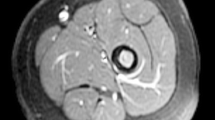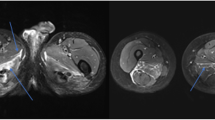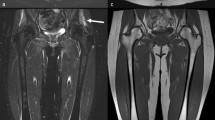Abstract
Objectives
Juvenile localized scleroderma (JLS) is a rare chronic autoimmune disease which can also affect bones and muscles. Nevertheless, muscle loss was not previously investigated in patients with JLS. Thus, the aim of this study was to retrospectively evaluate deep involvement and assess and quantify sarcopenia in JLS patients using magnetic resonance imaging (MRI).
Methods
Fourteen children with JLS (nine females, mean age ± SD, 7.1 ± 3.6 years) referring to our tertiary center from January 2012 to January 2018 who underwent at least one MRI examination including axial T1-weighted and short tau inversion recovery images were included. Two readers assessed in consensus superficial and deep involvement. Muscle edema, muscle fatty infiltration, and sarcopenia were independently scored (absent, moderate, or severe) and the Cohen’s kappa coefficient computed. Skin perimeter, subcutaneous area, muscle area, and muscle volume were independently measured using the contralateral unaffected extremity as reference (paired Student’s t test, p < 0.05). The intraclass correlation coefficient (ICC) was used to investigate the reliability of the measurements.
Results
All patients showed superficial involvement with subcutaneous fat atrophy being the most common finding (13 patients). Bone marrow edema occurred in five patients. Muscle edema affected ten children (moderate in seven, severe in three; k = 0.89), muscle fatty replacement occurred in one case (severe; k = 1.00), and sarcopenia was detected in eight patients (severe in two; k = 0.78). All quantitative parameters were lower on the affected side than on the unaffected contralateral limb (p < 0.05, each) and all measurements showed a high reliability (ICC > 0.750, each).
Conclusion
Patients with JLS can be affected by sarcopenia and quantitative analyses allow a robust characterization of such finding.
Key Points
• Deep involvement in juvenile localized scleroderma is frequently characterized by sarcopenia.
• In juvenile localized scleroderma, muscle edema and sarcopenia are mostly moderate while fatty infiltration, even if rare, can be severe.
• Sarcopenia can be reliably quantified in children with juvenile localized scleroderma using MRI.




Similar content being viewed by others
Abbreviations
- CI:
-
Confidence interval
- ICC:
-
Intraclass correlation coefficient
- JLS:
-
Juvenile localized scleroderma
- k :
-
Cohen’s kappa
- MA:
-
Muscle area
- MRI:
-
Magnetic resonance imaging
- MV:
-
Muscle volume
- SA:
-
Subcutaneous area
- SP:
-
Skin perimeter
- STIR:
-
Short tau inversion recovery
- TSE:
-
Turbo spin echo
References
Herrick AL, Ennis H, Bhushan M, Silman AJ, Baildam EM (2010) Incidence of childhood linear scleroderma and systemic sclerosis in the UK and Ireland. Arthritis Care Res (Hoboken) 62:213–218
Zulian F, Vallongo C, Woo P et al (2005) Localized scleroderma in childhood is not just a skin disease. Arthritis Rheum 52:2873–2881
Zulian F, Athreya BH, Laxer R et al (2006) Juvenile localized scleroderma: clinical and epidemiological features in 750 children: an international study. Rheumatology (Oxford) 45:614–620
Laxer RM, Zulian F (2006) Localized scleroderma. Curr Opin Rheumatol 18:606–613
Torok KS (2012) Pediatric scleroderma: systemic or localized forms. Pediatr Clin North Am 59:381–405
Zulian F (2017) Scleroderma in children. Best Pract Res Clin Rheumatol 31:576–595
Fett N, Werth VP (2011) Update on morphea: part I. epidemiology, clinical presentation, and pathogenesis. J Am Acad Dermatol 64:217–228
Tekin NS, Altinyazar HC, Tekin IO, Keskin SI, Kucukoglu R, Onsun N (2010) Disabling pansclerotic morphoea: a case report. Int J Clin Pract 64:99–101
Kroft EB, de Jong EM, Evers AW (2008) Physical burden of symptoms in patients with localized scleroderma and eosinophilic fasciitis. Arch Dermatol 144:1394–1395
Martini G, Ramanan AV, Falcini F, Girschick H, Goldsmith DP, Zulian F (2009) Successful treatment of severe or methotrexate-resistant juvenile localized scleroderma with mycophenolate mofetil. Rheumatology (Oxford) 48:1410–1413
Schanz S, Henes J, Ulmer A et al (2013) Response evaluation of musculoskeletal involvement in patients with deep morphea treated with methotrexate and prednisolone: a combined MRI and clinical approach. AJR Am J Roentgenol 200:W376–W382
Böckle BC, Willeit J, Freund M, Sepp NT (2009) Neurological picture. Unexplained muscle atrophy as the unique preceding symptom of bilateral linear morphea. J Neurol Neurosurg Psychiatry 80:310–311
Zivković SA, Freiberg W, Lacomis D, Domsic RT, Medsger TA (2014) Localized scleroderma and regional inflammatory myopathy. Neuromuscul Disord 24:425–430
Careta MF, Romiti R (2015) Localized scleroderma: clinical spectrum and therapeutic update. An Bras Dermatol 90:62–73
Lythgoe H, Almeida B, Bennett J et al (2018) Multi-centre national audit of juvenile localised scleroderma: describing current UK practice in disease assessment and management. Pediatr Rheumatol Online J 16:80
Kelsey CE, Torok KS (2013) The localized scleroderma cutaneous assessment tool: responsiveness to change in a pediatric clinical population. J Am Acad Dermatol 69:214–220
Garcia-Romero MT, Randhawa HK, Laxer R, Pope E (2017) The role of local temperature and other clinical characteristics of localized scleroderma as markers of disease activity. Int J Dermatol 56:63–67
Horger M, Fierlbeck G, Kuemmerle-Deschner J et al (2008) MRI findings in deep and generalized morphea (localized scleroderma). AJR Am J Roentgenol 190:32–39
Schanz S, Fierlbeck G, Ulmer A et al (2011) Localized scleroderma: MR findings and clinical features. Radiology 260:817–824
Eutsler EP, Horton DB, Epelman M, Finkel T, Averill LW (2017) Musculoskeletal MRI findings of juvenile localized scleroderma. Pediatr Radiol 47:442–449
Cicchetti DV (1994) Guidelines, criteria, and rules of thumb for evaluating normed and standardized assessment instruments in psychology. Psychol Assess 6:284–290
Albano D, Messina C, Vitale J, Sconfienza LM (2019) Imaging of sarcopenia: old evidence and new insights. Eur Radiol. https://doi.org/10.1007/s00330-019-06573-2
Huang CWC, Tseng IJ, Yang SW, Lin YK, Chan WP (2019) Lumbar muscle volume in postmenopausal women with osteoporotic compression fractures: quantitative measurement using MRI. Eur Radiol 29:4999–5006
Sconfienza LM (2019) Sarcopenia: ultrasound today, smartphones tomorrow? Eur Radiol 201(29):1–2
Faron A, Pieper CC, Schmeel FC et al (2019) Fat-free muscle area measured by magnetic resonance imaging predicts overall survival of patients undergoing radioembolization of colorectal cancer liver metastases. Eur Radiol 29:4709–4717
Schlaeger S, Inhuber S, Rohrmeier A et al (2019) Association of paraspinal muscle water–fat MRI-based measurements with isometric strength measurements. Eur Radiol 29:599–608
Ooi PH, Thompson-Hodgetts S, Pritchard-Wiart L, Gilmour SM, Mager DR (2019) Pediatric sarcopenia: a paradigm in the overall definition of malnutrition in children? JPEN J Parenter Enteral Nutr. https://doi.org/10.1002/jpen.1681
Suzuki D, Kobayashi R, Sano H, Hori D, Kobayashi K (2018) Sarcopenia after induction therapy in childhood acute lymphoblastic leukemia: its clinical significance. Int J Hematol 107:486–489
Giraudo C, Motyka S, Weber M et al (2018) Normalized STEAM-based diffusion tensor imaging provides a robust assessment of muscle tears in football players: preliminary results of a new approach to evaluate muscle injuries. Eur Radiol 28:2882–2889
Zannin ME, Martini G, Athreya BH et al (2007) Ocular involvement in children with localized scleroderma: a multicenter study. Br J Ophthalmol 91:1311–1314
Kashem SW, Correll CK, Vehe RK, Hobday PM, Binstadt BA, Maguiness SM (2018) Inflammatory arthritis in pediatric patients with morphea. J Am Acad Dermatol 79:47–52
Funding
The authors state that this work has not received any funding.
Author information
Authors and Affiliations
Corresponding author
Ethics declarations
Guarantor
The scientific guarantor of this publication is Dr. Chiara Giraudo, MD, PhD.
Conflict of interest
The authors of this manuscript declare no relationships with any companies whose products or services may be related to the subject matter of the article.
Statistics and biometry
Michael Weber kindly provided statistical advice for this manuscript.
Informed consent
Written informed consent was not required for this study because it is retrospective but the parents gave written informed consent to the MRI examination, as usually performed in clinical practice, since all patients were minor.
Ethical approval
Institutional Review Board approval was obtained.
Methodology
• Retrospective
• Cross sectional study
• Performed at one institution
Additional information
Publisher’s note
Springer Nature remains neutral with regard to jurisdictional claims in published maps and institutional affiliations.
Rights and permissions
About this article
Cite this article
Flores Quispe, S.K.J., Cavaliere, A., Weber, M. et al. Sarcopenia in juvenile localized scleroderma: new insights on deep involvement. Eur Radiol 30, 4091–4097 (2020). https://doi.org/10.1007/s00330-020-06764-2
Received:
Revised:
Accepted:
Published:
Issue Date:
DOI: https://doi.org/10.1007/s00330-020-06764-2




